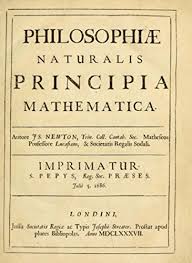Issac Newton’s 1687 publication of Mathematical Principles of Natural Philosophy, more commonly known as Principia, may have been the most important and influential scientific works of literature of all time. It’s impact on scientists was enormous and it immediately introduced a new paradigm in physics.
The State of Science Prior to Newtonian Physics
The 17th century marked an advancement and flourishing of modern science. Aristotelian teachings and the ideas of Christian theologians were coming into question as new observations about the way the universe actually worked were being discovered. Galileo Galilei had recently peered further into the universe, proving once and for all that not all heavenly bodies orbit the Earth. The French philosopher and mathematician Rene Descartes placed an emphasis on mathematical explanations. Newton titled his Principia as an allusion to Descartes’ Principles of Philosophy.
The discovery that most affected Newton and his publishing of the Principia was that of Johannes Kepler. One of the biggest problem facing astronomers at the time was determining how the planets moved against the background of fixed stars. Kepler had put forth three “laws” of planetary motion that show the planets move in an elliptical motion around the Sun. However at the time these laws were known to be close approximations, and there were several other methods that could be used to calculate planetary motion with comparable accuracy.
Newton’s Masterpiece

Isaac Newton may have solved the problem of orbital dynamics in 1679, but his solution was unknown to the rest of the scientific world. This changed in 1684 when Edmond Halley came to visit Newton while in Cambridge. During their conversations the topic of planetary motion was brought up. According the the French mathematician Abraham Demoivre’s account of a conversation he had with Newton: “The Dr asked him what he thought the Curve would be that would be described by the Planets supposing the force of attraction towards the Sun to be reciprocal to the square of the distance from it. Sir Isaac replied immediately that it would be an Ellipsi. . . . Dr Halley asked him for his calculation without any further delay. Sir Isaac looked among his papers but could not find it, but he promised him to renew it, and then to send it [to] him.”
In 1684 Newton made good on his promise and sent to Halley a paper on orbital dynamics titled On the Motion of Bodies in an Orbit. After two and a half years of work Newton expanded on this paper to produce his masterpiece Mathematical Principles of Natural Philosophy. Newton published his work into a three Book series. Book One is focused on motion in a medium devoid of resistance. Book Two is focused with motion in a resistive medium. Book Three is an analysis of some specific celestial data and the focuses on the consequences of universal gravitation.
Principia was important for its all-encompassing explanation of physics expressed in mathematical form. Two major ideas were expressed in the book. First, it stated Newton’s famous laws of motion which form the foundation of classical physics. These are:
- The law of inertia: An object at rest remains at rest. At object at motion will continue moving in a straight line at a constant velocity unless acted upon by a force.
- The law of force: The famous equation F=MA where force equals mass times acceleration.
- The law of equal and opposite reaction: This law states that when two bodies impact they apply forces to each other that are equal in magnitude and opposite in direction.
Second, it stated Newton’s law of universal gravitation. This law states that two masses attract each other by a constant multiplied by the product of the two masses and divided by the square of the distance between them. Stated another way, this is an inverse-square law of gravitation. All of these laws were proven with rigorous mathematical and experimental evidence.
Principia’s Lasting Legacy
The methods and laws in the Principia provided an unrivaled and highly accurate description of the physical universe for the time, making it one of the most important science books ever published. It established mathematics as the language of the physical sciences and continued in the Baconian tradition of relying on observation and experimentation. Newtonian mechanics, as his principles became to be known, were extremely important due to its useful value in everyday life. These methods and equations could be used in a variety of fields such as engineering, astronomy, industry, and agriculture.
Continue reading more about the exciting history of science!